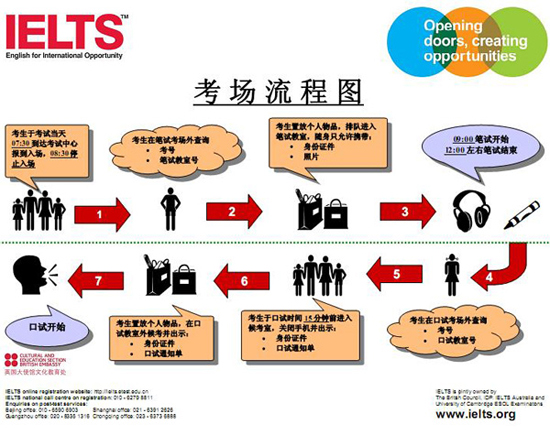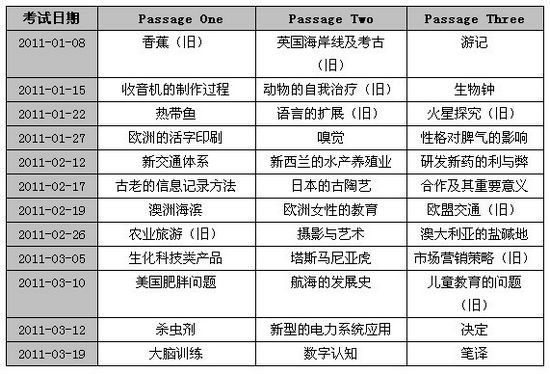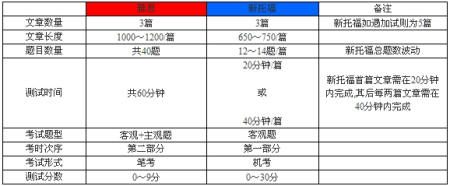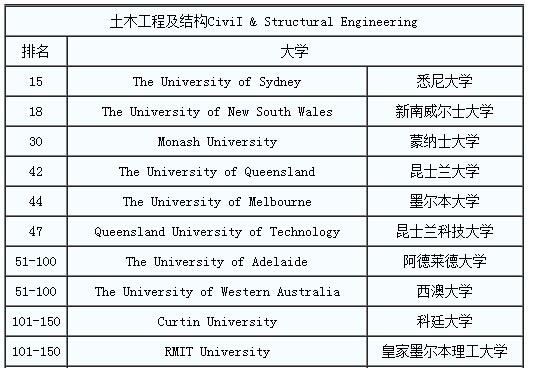来自:查字典高考网 2014-12-25
Earths Interior Plate Tectonics
Just as a child may shake an unopened present in an attempt to discover the contents of a gift, so man must listen to the ring and vibration of our Earth in an attempt to discover its content. This is accomplished through seismology, which has become the principle method used in studying Earths interior. Seismos is a Greek word meaning shock; akin to earthquake, shake, or violently moved. Seismology on Earth deals with the study of vibrations that are produced by earthquakes, the impact of meteorites, or artificial means such as an explosion. On these occasions, a seismograph is used to measure and record the actual movements and vibrations within the Earth and of the ground.
Types of seismic waves
(Adapted from, Beatty, 1990.)
Scientists categorize seismic movements into four types of diagnostic waves that travel at speeds ranging from 3 to 15 kilometers (1.9 to 9.4 miles) per second. Two of the waves travel around the surface of the Earth in rolling swells. The
other two, Primary (P) or compression waves and Secondary (S) or shear waves, penetrate the interior of the Earth. Primary waves compress and dilate the matter they travel through (either rock or liquid) similar to sound waves. They also have the ability to move twice as fast as S waves. Secondary waves propagate through rock but are not able to travel through liquid. Both P and S waves refract or reflect at points where layers of differing physical properties meet. They also reduce speed when moving through hotter material. These changes in direction and velocity are the means of locating discontinuities.
Divisions in the Earths Interior
(Adapted from, Beatty, 1990.)
Seismic discontinuities aid in distinguishing divisions of the Earth into inner core, outer core, D, lower mantle, transition region, upper mantle, and crust (oceanic and continental). Lateral discontinuities also have been distinguished
and mapped through seismic tomography but shall not be discussed here.
Inner core: 1.7% of the Earth depth of 5,150-6,370 kilometers (3,219 - 3,981 miles)
The inner core is solid and unattached to the mantle, suspended in the molten outer core. It is believed to have solidified as a result of pressure-freezing which occurs to most liquids when temperature decreases or pressure increases.
Outer core: 30.8% of Earth depth of 2,890-5,150 kilometers (1,806 - 3,219 miles)
The outer core is a hot, electrically conducting liquid within which convective motion occurs. This conductive layer combines with Earths rotation to create a dynamo effect that maintains a system of electrical currents known as the Earths magnetic field. It is also responsible for the subtle jerking of Earths rotation. This layer is not as dense as pure molten iron, which indicates the presence of lighter elements. Scientists suspect that about 10% of the layer is composed of sulfur and/or oxygen because these elements are abundant in the cosmos and dissolve readily in molten iron. D: 3% of Earth depth of 2,700-2,890 kilometers (1,688 - 1,806 miles)
This layer is 200 to 300 kilometers (125 to 188 miles) thick and represents about 4% of the mantle-crust mass. Although it is often identified as part of the lower mantle, seismic discontinuities suggest the D layer might differ chemically from the lower mantle lying above it. Scientists theorize that the material either dissolved in the core, or was able to sink through the mantle but not into the core because of its density.
Lower mantle: 49.2% of Earth depth of 650-2,890 kilometers (406 -1,806 miles)
The lower mantle contains 72.9% of the mantle-crust mass and is probably composed mainly of silicon, magnesium, and oxygen. It probably also contains some iron, calcium, and aluminum. Scientists make these deductions by assuming the Earth has a similar abundance and proportion of cosmic elements as found in the Sun and primitive meteorites.
Transition region: 7.5% of Earth depth of 400-650 kilometers (250-406 miles)
The transition region or mesosphere (for middle mantle), sometimes called the fertile layer, contains 11.1% of the mantle-crust mass and is the source of basaltic magmas. It also contains calcium, aluminum, and garnet, which is a complex aluminum-bearing silicate mineral. This layer is dense when cold because of the garnet. It is buoyant when hot because these minerals melt easily to form basalt which can then rise through the upper layers as magma.
Upper mantle: 10.3% of Earth depth of 10-400 kilometers (6 - 250 miles)
The upper mantle contains 15.3% of the mantle-crust mass. Fragments have been excavated for our observation by eroded mountain belts and volcanic eruptions.
Olivine (Mg,Fe)2SiO4 and pyroxene (Mg,Fe)SiO3 have been the primary minerals found in this way. These and other minerals are refractory and crystalline at high temperatures; therefore, most settle out of rising magma, either forming new crustal material or never leaving the mantle. Part of the upper mantle called the asthenosphere might be partially molten.
Oceanic crust: 0.099% of Earth depth of 0-10 kilometers (0 - 6 miles)
The oceanic crust contains 0.147% of the mantle-crust mass. The majority of the Earths crust was made through volcanic activity. The oceanic ridge system, a 40,000-kilometer (25,000 mile) network of volcanoes, generates new oceanic crust at the rate of 17 km3 per year, covering the ocean floor with basalt. Hawaii and Iceland are two examples of the accumulation of basalt piles.
Continental crust: 0.374% of Earth depth of 0-50 kilometers (0 - 31 miles).
The continental crust contains 0.554% of the mantle-crust mass. This is the outer part of the Earth composed essentially of crystalline rocks. These are low-density buoyant minerals dominated mostly by quartz (SiO2) and feldspars
(metal-poor silicates). The crust (both oceanic and continental) is the surface of the Earth; as such, it is the coldest part of our planet. Because cold rocks deform slowly, we refer to this rigid outer shell as the lithosphere (the rocky or strong layer).
The Lithosphere Plate Tectonics
Oceanic Lithosphere
The rigid, outermost layer of the Earth comprising the crust and upper mantle is called the lithosphere. New oceanic lithosphere forms through volcanism in the form of fissures at mid-ocean ridges which are cracks that encircle the globe.
Heat escapes the interior as this new lithosphere emerges from below. It gradually cools, contracts and moves away from the ridge, traveling across the seafloor to subduction zones in a process called seafloor spreading. In time, older lithosphere will thicken and eventually become more dense than the mantle below, causing it to descend (subduct) back into the Earth at a steep angle, cooling the interior. Subduction is the main method of cooling the mantle below 100 kilometers (62.5 miles). If the lithosphere is young and thus hotter at a subduction zone, it will be forced back into the interior at a lesser angle.
Continental Lithosphere
The continental lithosphere is about 150 kilometers (93 miles) thick with a low-density crust and upper-mantle that are permanently buoyant. Continents drift laterally along the convecting system of the mantle away from hot mantle zones toward cooler ones, a process known as continental drift. Most of the continents are now sitting on or moving toward cooler parts of the mantle, with the exception of Africa. Africa was once the core of Pangaea, a supercontinent that eventually broke into todays continents. Several hundred million years prior to the formation of Pangaea, the southern continents - Africa, South America, Australia, Antarctica, and India - were assembled together in what is called Gondwana. Plate Tectonics
Crustal Plate Boundaries
(Courtesy NGDC)
Plate tectonics involves the formation, lateral movement, interaction, and destruction of the lithospheric plates. Much of Earths internal heat is relieved through this process and many of Earths large structural and topographic features are consequently formed. Continental rift valleys and vast plateaus of basalt are created at plate break up when magma ascends from the mantle to the ocean floor, forming new crust and separating midocean ridges. Plates collide and are destroyed as they descend at subduction zones to produce deep ocean trenches, strings of volcanoes, extensive transform faults, broad linear rises, and folded mountain belts. Earths lithosphere presently is divided into eight large plates with about two dozen smaller ones that are drifting above the mantle at the rate of 5 to 10 centimeters (2 to 4 inches) per
year. The eight large plates are the African, Antarctic, Eurasian, Indian-Australian, Nazca, North American, Pacific, and South American plates. A few of the smaller plates are the Anatolian, Arabian, Caribbean, Cocos, Philippine, and Somali plates.
Views of the Solar System Copyright 1997-2001 by Calvin J. Hamilton. All rights reserved. Privacy Statement.
【新托福阅读复习材料:美国科学文摘精选(二)】相关文章:
[标签:海外留学,语言考试,托福,,]
 雅思考试考场流程图
雅思考试考场流程图  2011第一季度雅思阅读回顾与解析
2011第一季度雅思阅读回顾与解析  雅思vs托福 阅读异同大盘点对照表
雅思vs托福 阅读异同大盘点对照表  中学生雅思阅读快速提高的秘密
中学生雅思阅读快速提高的秘密  澳洲留学热门专业:土木工程专业排名
澳洲留学热门专业:土木工程专业排名  雅思听力周周练第四期-参赛篇
雅思听力周周练第四期-参赛篇 北京新闻 2019 5.9万余北京考生今日高考 语文试题鼓励创造性阅读与表达
探秘历史 第二季 第233集 考英语用来睡觉,结果仍是高考状元,如今她怎么样了?
高考体育四项生的日常训练——深蹲移动跳:发展膝关节,踝关节力量。
爆笑班主任 第一季 第220集 高考前最后一只视频,山东王老师揭秘高考的秘密
广州早晨 2019 山西一高中班主任带学生骑行1800公里去上海
高考阅卷名师给考生的高考作文密训课 第3集 高考作文审题实操方法精讲(一)
乾坤已定,组合解读2019高考数学全国3卷理科18题,你是黑马吗?
高中语文知识清单高考语文总複习工具书第5次修订五全綵版五三曲一线科学备考基础知识手册知识大集结资料书参考书导书高一高二高三